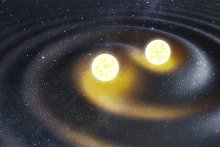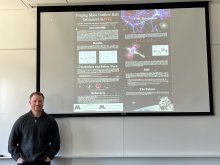News

Researchers advance detection of gravitational waves to study collisions of neutron stars and black holes
Posted
Alerts can now be sent less than 30 seconds after detection.

UM Investigators Selected as PIs for James Webb Telescope Cycle 3
Posted
UM Investigators Selected as PIs for James Webb Telescope Cycle 3

Coughlin, Citro, and Criswell part of comprehensive UV light survey
Posted
Assistant Professor Michael Coughlin, postdoctoral researcher Annalisa Citro, and graduate student Alexander Criswell of the Minnesota Institute for Astrophysics are part of a new mission that has just been selected to conduct a comprehensive survey of ultraviolet light spanning the entire sky

Two astrophysics Alumni elected to National Academy of Engineering
Posted
Two astrophysics Alumni Martha C. Anderson (Ph.D., Astrophysics ‘93), Kei May Lau (B.A.,’76, M.S. ‘77), and Jeffrey Puschell (Ph.D., Astrophysics ‘79), have been elected to the National Academy of Engineering (NAE) for 2024.

Assistant Professor Michael Coughlin has been awarded a 2024 McKnight Land-Grant Professorship
Posted
Assistant Professor Michael Coughlin has been awarded a 2024 McKnight Land-Grant Professorship, which recognizes outstanding accomplishments and promise among the University's assistant professors.

Observations of Dramatic Galactic Collision Unlock Clues to the Reionization of the Universe
Posted
An international team, led by Dr. Alexandra Le Reste from Stockholm University and the Oskar Klein Centre, used the MeerKAT radio telescope to investigate processes at the origin of the Epoch of Reionization, a crucial period occurring a billion years after the Big Bang. The study, made possible by MeerKAT's increased sensitivity relative to older telescopes, reveals how galaxy mergers might have influenced the transformation of the Universe during this epoch.

Professor Emerita Roberta Humphreys receives Herschel Medal of the Royal Astronomical Society for 2024
Posted
Herschel Medal of the Royal Astronomical Society for 2024


Roman space telescope mission head from UMN
Posted
Dr. Kristen McQuinn is a UMN astrophysics Ph.D. who has been selected to be the Roman space telescope mission head.

Dr. Carr took home the grand prize in the physical sciences division
Posted
Dr. Carr took home the grand prize in the physical sciences division - a travel stipend worth up to $2000.